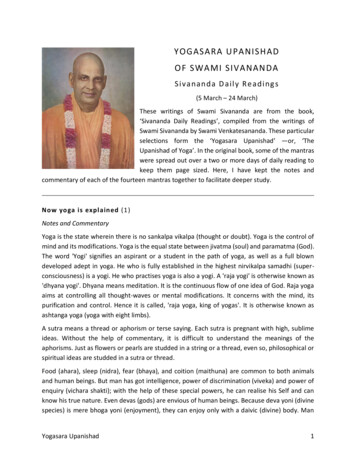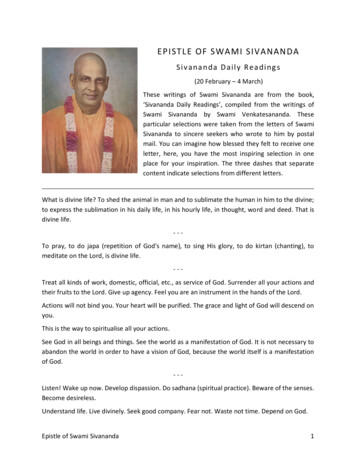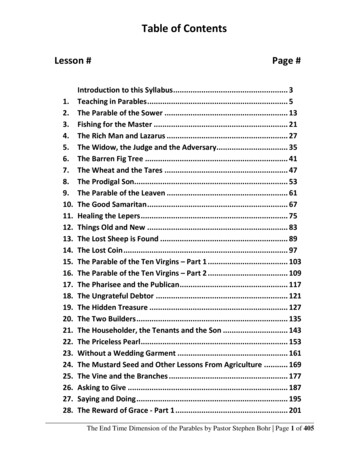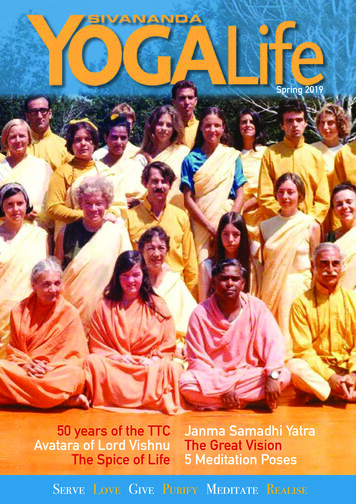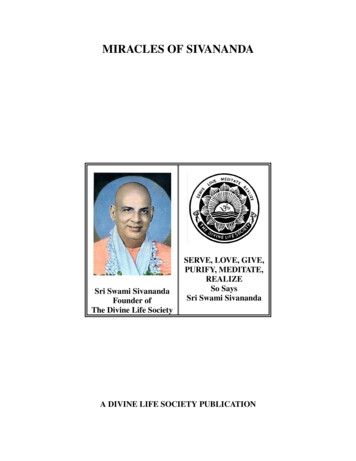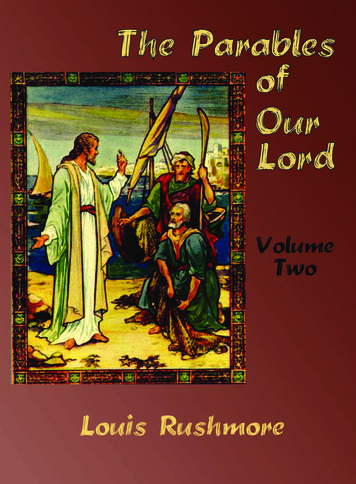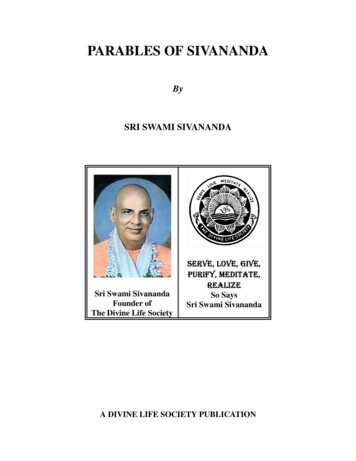
Transcription
PARABLES OF SIVANANDABySRI SWAMI SIVANANDASri Swami SivanandaFounder ofThe Divine Life Society6(59( /29( *,9( 385,) 0(',7 7( 5( /, (So SaysSri Swami SivanandaA DIVINE LIFE SOCIETY PUBLICATION
First Edition:1955Second Edition:1983Third Edition:1993(4,000 copies)World Wide Web (WWW) Edition : 1998WWW site: http://www.rsl.ukans.edu/ pkanagar/divine/This WWW reprint is for free distribution The Divine Life Trust SocietyISBN 81-7052-037-1Published ByTHE DIVINE LIFE SOCIETYP.O. SHIVANANDANAGAR—249 192Distt. Tehri-Garhwal, Uttar Pradesh,Himalayas, India.
PUBLISHERS’ NOTETruth is simple. Simple are the words of God-realised saint. How simply our Gurudev, SriSwami Sivanandaji Maharaj, states the subtlest of spiritual truths, so that even laymen canunderstand! The Sage’s compassion is such that he wants the truths of the scriptures to be madeavailable to all, to whatever intellectual level they may belong. Therefore, he has literally exhaustedall the methods of stating the truth. He has written commentaries on ancient texts; he has presentedlearned theses on metaphysical questions; he has narrated them in the form of interesting stories; hehas given laconic expression to them in aphorisms; he has vividly dramatised them in his plays; hehas sung them in songs and woven them into sublime poems; and now comes another potentmethod of instruction—the Parable. The story is interesting; the mind readily grasps it. Thespiritual truth which is the other side of the story automatically gets inerasably lodged in the mind.The truth becomes not only clear, but indelible.These Parables are of incalculable benefit not only for the Sadhaka to meditate upon, but forthe spiritual propagandist—with the parables he can drive his sermon home into the heart of theaudience.—THE DIVINE LIFE SOCIETYiii
BHAKTI COMMANDMENTS1. Develop devotion through Japa, Kirtan, Sattvic food, worship (Puja) etc. Yearn for God-vision.Love Him with all your heart. Remember Him constantly.2. Keep the company of saints, the righteous and the wise. Study devotional books like the Gita,the Bhagavata, the Ramayana, the lives of Saints.3. The Name of the Lord is Divine Nectar. Name is your sole Refuge, Prop and Treasure. Nameand Nami (God) are one. Always chant His Names with devotion. Do Kirtan. This is the principalSadhana in Kali-Yuga.4. Pray to the Lord from the core of your heart: “I am Thine. All is Thine. Thy Will be done. I aman instrument in Thy Hands. You do everything. You are Just. Grant me faith and devotion.”5. Feel the Presence of God with you. See God in every face. Behold the whole world as the Lord.6. Practice Sadachara (right conduct). Cultivate virtues and eradicate vices. Be good. Be kind toall. Be humble. Be pure. Speak the truth. Control anger. Have a large heart. Develop compassion.7. Teach the eye to behold the Form of the Lord. Teach the ear to hear the Lord’s Lilas and Glory.Teach the hands to serve the saints and the poor.8. Take refuge in the Lord. Do total, ungrudging self-surrender. Live for Him. Offer your actionsto Him. His Grace will descend on you.9. Have perfect trust in God. Faith is necessary to attain God. Faith can take you to the innerchambers of the Lord.10. Constantly repeat some inspiring verses (praises of God’s Glory) or some Mantras, or theNames of God. This will be your Divine background of thought.iv
GLORY OF RAMA NAMA1. Glories of Rama Nama are innumerable.2. Rama who is All-pervading is realised when the devotee of Sri Rama annihilates egoism, andwhen all attachments due to egoism disappear by Rama Smarana (remembrance at all times).3. Sri Rama resides in the heart of all individual souls.4. Rama loves His devotee when he has surrendered his individual self at the feet of Rama.5. In divine love the devotee is blessed by all-pervading Lord Rama with Self-Bliss.6. The devotee is always at the feet (at the mercy) of Rama.7. Rama loves His lover, and thus the devotee is initiated into Rama Nama by Rama Himself.8. The devotee is full of Self-Bliss, and does not feel the necessity of any more than what isacquired through right endeavour by the Grace of Rama.9. Sri Rama’s devotee is directly under the shelter of Rama, and feels joy in the prayer: “O myLord Rama; ever live in my heart and bless thy humble devotee with Thy Love only.”10. The devotee finds Rama in all individual souls, and Divine Love is directed by Rama, andblessed with patience.11. Rama’s devotee is always at the Feet of Rama, and works under the order and Will of Rama.The devotee of Rama works in his own self, belonging to Rama. The devotee devotes his self solelyat the Feet of Rama.12. May All-pervading Rama bless all humanity with Divine Love!v
CONTENTSPUBLISHERS’ NOTE . . . . . . . . . . . . . . . . . . . . . . . . . . . . . . . . . . . . . . iiiBHAKTI COMMANDMENTS . . . . . . . . . . . . . . . . . . . . . . . . . . . . . . . . . ivGLORY OF RAMA NAMA . . . . . . . . . . . . . . . . . . . . . . . . . . . . . . . . . . . vPART ONE: PHILOSOPHY AND TEACHINGSPHILOSOPHY . . . . . . . . . . . . . . . . . . . . . . . . . . . . . . . . . . . . . . . . . . 1Parable Of The Butter Hidden In The Milk . . . . . . . . . . . . . . . . . . . . . . . . . . . . . . . . . . . . . . . . . . 1Parable Of The Crow On The House-Top . . . . . . . . . . . . . . . . . . . . . . . . . . . . . . . . . . . . . . . . . . . 2Parable Of The King’s Dream . . . . . . . . . . . . . . . . . . . . . . . . . . . . . . . . . . . . . . . . . . . . . . . . . . . . 2Parable Of The Woman Who Wanted To Adorn Her Reflection. . . . . . . . . . . . . . . . . . . . . . . . . . 3Parable Of The Jack-Fruit In The Courtyard . . . . . . . . . . . . . . . . . . . . . . . . . . . . . . . . . . . . . . . . . 3Parable Of The Man And His Dog . . . . . . . . . . . . . . . . . . . . . . . . . . . . . . . . . . . . . . . . . . . . . . . . . 5Parable Of The Zamindar And His Agent . . . . . . . . . . . . . . . . . . . . . . . . . . . . . . . . . . . . . . . . . . . 5Parable Of The Lost Wrist-Watch . . . . . . . . . . . . . . . . . . . . . . . . . . . . . . . . . . . . . . . . . . . . . . . . . 6Parable Of The Door-Mat . . . . . . . . . . . . . . . . . . . . . . . . . . . . . . . . . . . . . . . . . . . . . . . . . . . . . . . . 7Parable Of The Camel’s Satisfactions . . . . . . . . . . . . . . . . . . . . . . . . . . . . . . . . . . . . . . . . . . . . . . 7Parable Of The Passenger And His Luggage . . . . . . . . . . . . . . . . . . . . . . . . . . . . . . . . . . . . . . . . . 7Parable Of The Man Who Lost His Mind. . . . . . . . . . . . . . . . . . . . . . . . . . . . . . . . . . . . . . . . . . . . 8Parable Of The Greedy Pilgrim . . . . . . . . . . . . . . . . . . . . . . . . . . . . . . . . . . . . . . . . . . . . . . . . . . . 8THE SUPREME PURPOSE OF HUMAN BIRTH . . . . . . . . . . . . . . . . . . . . . . 9Parable Of The Boy Who Watered The Root . . . . . . . . . . . . . . . . . . . . . . . . . . . . . . . . . . . . . . . . . 9Parable Of The Pandit And The Shawl. . . . . . . . . . . . . . . . . . . . . . . . . . . . . . . . . . . . . . . . . . . . . . 9Parable Of The Cat In The Hammock . . . . . . . . . . . . . . . . . . . . . . . . . . . . . . . . . . . . . . . . . . . . . 10Parable Of The Prostitute And Her Lover . . . . . . . . . . . . . . . . . . . . . . . . . . . . . . . . . . . . . . . . . . 10Parable Of The Jalataranga Player And His Cup . . . . . . . . . . . . . . . . . . . . . . . . . . . . . . . . . . . . . 11Parable Of The Koshakara Bird . . . . . . . . . . . . . . . . . . . . . . . . . . . . . . . . . . . . . . . . . . . . . . . . . . 12Parable Of The Man Who Was Afraid Of Mosquitoes. . . . . . . . . . . . . . . . . . . . . . . . . . . . . . . . . 12Parable Of Two Businessmen. . . . . . . . . . . . . . . . . . . . . . . . . . . . . . . . . . . . . . . . . . . . . . . . . . . . 12Parable Of The Two Birds And Garuda . . . . . . . . . . . . . . . . . . . . . . . . . . . . . . . . . . . . . . . . . . . . 13THE GLORY OF THE GURU. . . . . . . . . . . . . . . . . . . . . . . . . . . . . . . . . 14Parable Of The Blind Leading The Blind . . . . . . . . . . . . . . . . . . . . . . . . . . . . . . . . . . . . . . . . . . . 14Parable Of The Cunning Man And Four Fools. . . . . . . . . . . . . . . . . . . . . . . . . . . . . . . . . . . . . . . 15Parable Of The Millionaire’s Messenger . . . . . . . . . . . . . . . . . . . . . . . . . . . . . . . . . . . . . . . . . . . 15Parable Of The Pseudo-Bhakta. . . . . . . . . . . . . . . . . . . . . . . . . . . . . . . . . . . . . . . . . . . . . . . . . . . 16Parable Of The Brahmanishtha And His Disciple . . . . . . . . . . . . . . . . . . . . . . . . . . . . . . . . . . . . 16Parable Of The Good-Natured Youth And The Beautiful Girl. . . . . . . . . . . . . . . . . . . . . . . . . . . 17Parable Of The Well-Cooked Feast . . . . . . . . . . . . . . . . . . . . . . . . . . . . . . . . . . . . . . . . . . . . . . . 18Parable Of The Suspicious Man Who Got Drowned . . . . . . . . . . . . . . . . . . . . . . . . . . . . . . . . . . 19Parable Of The Luxurious Man . . . . . . . . . . . . . . . . . . . . . . . . . . . . . . . . . . . . . . . . . . . . . . . . . . 20Parable Of The T. B. Patient. . . . . . . . . . . . . . . . . . . . . . . . . . . . . . . . . . . . . . . . . . . . . . . . . . . . . 20vi
Parable Of The Deluded Pilgrim. . . . . . . . . . . . . . . . . . . . . . . . . . . . . . . . . . . . . . . . . . . . . . . . . . 21Parable Of The Sheep And The Wolf . . . . . . . . . . . . . . . . . . . . . . . . . . . . . . . . . . . . . . . . . . . . . . 21THE SADHAKA’S EQUIPMENT. . . . . . . . . . . . . . . . . . . . . . . . . . . . . . . 22Parable Of The Mourning Bird . . . . . . . . . . . . . . . . . . . . . . . . . . . . . . . . . . . . . . . . . . . . . . . . . . . 22Parable Of The Professional Bargainer. . . . . . . . . . . . . . . . . . . . . . . . . . . . . . . . . . . . . . . . . . . . . 23Parable Of The Gardener And The Shep Herd . . . . . . . . . . . . . . . . . . . . . . . . . . . . . . . . . . . . . . . 23Parable Of Jaggery God’s Naivedya. . . . . . . . . . . . . . . . . . . . . . . . . . . . . . . . . . . . . . . . . . . . . . . 24Parable Of The Patient Poor Man . . . . . . . . . . . . . . . . . . . . . . . . . . . . . . . . . . . . . . . . . . . . . . . . . 24Parable Of A King And His Hawk . . . . . . . . . . . . . . . . . . . . . . . . . . . . . . . . . . . . . . . . . . . . . . . . 26Parable Of The King And The Astrologer . . . . . . . . . . . . . . . . . . . . . . . . . . . . . . . . . . . . . . . . . . 27Parable Of The Bearded Man And Gruel . . . . . . . . . . . . . . . . . . . . . . . . . . . . . . . . . . . . . . . . . . 27Parable Of The Heiress Who Marries The Ugly Man . . . . . . . . . . . . . . . . . . . . . . . . . . . . . . . . . 28Parable Of The Snake And The Rat . . . . . . . . . . . . . . . . . . . . . . . . . . . . . . . . . . . . . . . . . . . . . . . 29Parable Of The Woman Who Advertised Her Connubial Experiences . . . . . . . . . . . . . . . . . . . . 30Parable Of The Bigoted Devotee . . . . . . . . . . . . . . . . . . . . . . . . . . . . . . . . . . . . . . . . . . . . . . . . . 31THE PATH OF SERVICE . . . . . . . . . . . . . . . . . . . . . . . . . . . . . . . . . . . 31Parable Of The Elephant’s Bath . . . . . . . . . . . . . . . . . . . . . . . . . . . . . . . . . . . . . . . . . . . . . . . . . . 31Parable Of The Mother’s Trick. . . . . . . . . . . . . . . . . . . . . . . . . . . . . . . . . . . . . . . . . . . . . . . . . . . 32Parable Of The Boy Who Purchased One Brinjal For The Rupee . . . . . . . . . . . . . . . . . . . . . . . . 32Parable Of The Honey And The Creeper . . . . . . . . . . . . . . . . . . . . . . . . . . . . . . . . . . . . . . . . . . . 33Parable Of The Ghee-Dyspeptic . . . . . . . . . . . . . . . . . . . . . . . . . . . . . . . . . . . . . . . . . . . . . . . . . . 34Parable Of The Man Who Washed Mud With Mud . . . . . . . . . . . . . . . . . . . . . . . . . . . . . . . . . . . 34Parable Of The Two Travellers. . . . . . . . . . . . . . . . . . . . . . . . . . . . . . . . . . . . . . . . . . . . . . . . . . . 35Parable Of The Zamindar’s Palace . . . . . . . . . . . . . . . . . . . . . . . . . . . . . . . . . . . . . . . . . . . . . . . . 35THE PATH OF GOD-LOVE. . . . . . . . . . . . . . . . . . . . . . . . . . . . . . . . . . 36Parable Of The Tailor’s Needle . . . . . . . . . . . . . . . . . . . . . . . . . . . . . . . . . . . . . . . . . . . . . . . . . . 36Parable Of The Ant And The Lizard . . . . . . . . . . . . . . . . . . . . . . . . . . . . . . . . . . . . . . . . . . . . . . 36Parable Of The Inveterate Old Man . . . . . . . . . . . . . . . . . . . . . . . . . . . . . . . . . . . . . . . . . . . . . . . 37Parable Of The Dacoit . . . . . . . . . . . . . . . . . . . . . . . . . . . . . . . . . . . . . . . . . . . . . . . . . . . . . . . . . 38Parable Of The Blessed Mouse. . . . . . . . . . . . . . . . . . . . . . . . . . . . . . . . . . . . . . . . . . . . . . . . . . . 38Parable Of The Millionaire And Three Beggars. . . . . . . . . . . . . . . . . . . . . . . . . . . . . . . . . . . . . . 38Parable Of The Wood-Cutter And Lord Yama. . . . . . . . . . . . . . . . . . . . . . . . . . . . . . . . . . . . . . . 39Parable Of The Brainy Boy. . . . . . . . . . . . . . . . . . . . . . . . . . . . . . . . . . . . . . . . . . . . . . . . . . . . . . 40Parable Of The Nobleman’s Charity. . . . . . . . . . . . . . . . . . . . . . . . . . . . . . . . . . . . . . . . . . . . . . . 40CONQUEST OF MIND . . . . . . . . . . . . . . . . . . . . . . . . . . . . . . . . . . . . 41Parable Of The Ants And Mountain Of Sugar . . . . . . . . . . . . . . . . . . . . . . . . . . . . . . . . . . . . . . . 41Parable Of The Girl Who Stopped The Policeman And The Thief . . . . . . . . . . . . . . . . . . . . . . . 42Parable Of The Poor Man And His Treasure-Trove. . . . . . . . . . . . . . . . . . . . . . . . . . . . . . . . . . . 42Parable Of The Weeds In The Field . . . . . . . . . . . . . . . . . . . . . . . . . . . . . . . . . . . . . . . . . . . . . . . 43Parable Of The Cheating Postmaster . . . . . . . . . . . . . . . . . . . . . . . . . . . . . . . . . . . . . . . . . . . . . . 43Parable Of The Man Who Cut The Cow’s Udder. . . . . . . . . . . . . . . . . . . . . . . . . . . . . . . . . . . . . 44Parable Of The Advocate’s Turban . . . . . . . . . . . . . . . . . . . . . . . . . . . . . . . . . . . . . . . . . . . . . . . 44vii
Parable Of A Hundred Children . . . . . . . . . . . . . . . . . . . . . . . . . . . . . . . . . . . . . . . . . . . . . . . . . . 45THE PATH OF THE WISE . . . . . . . . . . . . . . . . . . . . . . . . . . . . . . . . . . 46Parable Of The Grain And The Hay . . . . . . . . . . . . . . . . . . . . . . . . . . . . . . . . . . . . . . . . . . . . . . . 46Parable Of Four Learned Scholars . . . . . . . . . . . . . . . . . . . . . . . . . . . . . . . . . . . . . . . . . . . . . . . . 46Parable Of The Boy And The Candle . . . . . . . . . . . . . . . . . . . . . . . . . . . . . . . . . . . . . . . . . . . . . . 47Parable Of The People Who Died Of Fear . . . . . . . . . . . . . . . . . . . . . . . . . . . . . . . . . . . . . . . . . . 48THE NATURE OF THE JIVANMUKTA. . . . . . . . . . . . . . . . . . . . . . . . . . . 48Parable Of The Hunter’s Dream . . . . . . . . . . . . . . . . . . . . . . . . . . . . . . . . . . . . . . . . . . . . . . . . . . 48Parable Of The Torch In A Dark Room . . . . . . . . . . . . . . . . . . . . . . . . . . . . . . . . . . . . . . . . . . . . 49Parable Of The Child And The Shadow . . . . . . . . . . . . . . . . . . . . . . . . . . . . . . . . . . . . . . . . . . . . 49Parable Of The Fire’s Pollution . . . . . . . . . . . . . . . . . . . . . . . . . . . . . . . . . . . . . . . . . . . . . . . . . . 49Parable Of The Cows And The Scratching Pillar . . . . . . . . . . . . . . . . . . . . . . . . . . . . . . . . . . . . . 50PART TWO: OTHER PARABLESParable Of Raja Janaka And The Pandits . . . . . . . . . . . . . . . . . . . . . . . . . . . . . . . . . . . . . . . . . . . 51Parable Of The Old Lady And The Needle . . . . . . . . . . . . . . . . . . . . . . . . . . . . . . . . . . . . . . . . . 51Parable Of The Mother-In-Law And The Beggar. . . . . . . . . . . . . . . . . . . . . . . . . . . . . . . . . . . . . 52Parable Of The Young Man’s Boon . . . . . . . . . . . . . . . . . . . . . . . . . . . . . . . . . . . . . . . . . . . . . . . 52Parable Of The Sadhu And The Sword. . . . . . . . . . . . . . . . . . . . . . . . . . . . . . . . . . . . . . . . . . . . . 54Parable Of The Boy Who Could Not Tell The Time . . . . . . . . . . . . . . . . . . . . . . . . . . . . . . . . . . 55Parable Of The Bird And The Cotton-Fruit . . . . . . . . . . . . . . . . . . . . . . . . . . . . . . . . . . . . . . . . . 55Parable Of The Man In The Python’s Mouth . . . . . . . . . . . . . . . . . . . . . . . . . . . . . . . . . . . . . . . . 56Parable Of The Boy And The Angel. . . . . . . . . . . . . . . . . . . . . . . . . . . . . . . . . . . . . . . . . . . . . . . 56Parable Of Water And Fire . . . . . . . . . . . . . . . . . . . . . . . . . . . . . . . . . . . . . . . . . . . . . . . . . . . . . . 56Parable Of The Opium-Smokers And Moon’s Reflection . . . . . . . . . . . . . . . . . . . . . . . . . . . . . . 57Parable Of The Husband And The Wife. . . . . . . . . . . . . . . . . . . . . . . . . . . . . . . . . . . . . . . . . . . . 58Parable Of The Pet Child . . . . . . . . . . . . . . . . . . . . . . . . . . . . . . . . . . . . . . . . . . . . . . . . . . . . . . . 59Parable Of The Man And His Mud-Horse . . . . . . . . . . . . . . . . . . . . . . . . . . . . . . . . . . . . . . . . . . 60Parable Of The Philosopher And The Broken Mirror . . . . . . . . . . . . . . . . . . . . . . . . . . . . . . . . . 60Parable Of The Brahmin Who Escaped Rain . . . . . . . . . . . . . . . . . . . . . . . . . . . . . . . . . . . . . . . . 61Parable Of The Conductor Who Fell Off The Bus . . . . . . . . . . . . . . . . . . . . . . . . . . . . . . . . . . . . 61Parable Of The Manager Who Removed The Hands Of The Clock . . . . . . . . . . . . . . . . . . . . . . 62Parable Of The Boy And His Shoes . . . . . . . . . . . . . . . . . . . . . . . . . . . . . . . . . . . . . . . . . . . . . . . 62Parable Of The Masked Boy And The Mouse . . . . . . . . . . . . . . . . . . . . . . . . . . . . . . . . . . . . . . . 62Parable Of The Children’s Quarrel Over Mud-Houses . . . . . . . . . . . . . . . . . . . . . . . . . . . . . . . . 63Parable Of The Man Who Pretended To Be A Woman At Booking Office. . . . . . . . . . . . . . . . . 63Parable Of The Bullock-Cart Driver. . . . . . . . . . . . . . . . . . . . . . . . . . . . . . . . . . . . . . . . . . . . . . . 64Parable Of The Puranjana Maharaja . . . . . . . . . . . . . . . . . . . . . . . . . . . . . . . . . . . . . . . . . . . . . . . 64Parable Of The Unwary Deer . . . . . . . . . . . . . . . . . . . . . . . . . . . . . . . . . . . . . . . . . . . . . . . . . . . . 66Parable Of The Laconic Spartan . . . . . . . . . . . . . . . . . . . . . . . . . . . . . . . . . . . . . . . . . . . . . . . . . . 66Parable Of Mahmud And Ayaz. . . . . . . . . . . . . . . . . . . . . . . . . . . . . . . . . . . . . . . . . . . . . . . . . . . 67Parable Of “the Dramatic Show” . . . . . . . . . . . . . . . . . . . . . . . . . . . . . . . . . . . . . . . . . . . . . . . . . 68viii
Part OnePHILOSOPHY AND TEACHINGSChapter OnePHILOSOPHYParable Of The Butter Hidden In The MilkThe young daughter had gone to her village home for the first time from her city-dwelling.At night before retiring to bed, her mother opened a pot in which there was good cow’s milk andpoured a little buttermilk. The girl asked her mother: “Mother, that was butter milk; and why haveyou mixed it with Milk? The milk may be spoiled!” “Child,” answered the mother, “that is the wayto prepare the milk in order that we might get butter out of it.” “But where is butter in it, mother?”“It is in every drop of the milk, dear; but you can’t see it now. I will show you in the morning.” In themorning the daughter saw that what was liquid the night before had become solid overnight. Motherput a churning rod into it and started churning the curd vigorously. Butter began to float on thesurface of the curd. Then she gathered it all up and presented it to the astonishment of the daughter.The mother explained: “The addition of the buttermilk curdles the milk. Milk is transformed intocurd. Then you have to churn it. By this process the butter which was all-pervasively hidden in themilk is obtained. At first you were not able to see it; it was hidden. From where has it come now?From the milk only. Therefore you understand now that it was there all the time. It awaited theprocess of churning to reveal itself to your great joy.” The daughter, too, followed the same processand got the butter, for herself.Similarly, a worldly man approaches a Mahatma and asks him: “O Sadhu, why have yourenounced the world, and poured this new element of Vairagya and Tyaga into your life? Why don’tyou let the life take its natural course?” The Sadhu replies: “Brother, I do so in order to realiseGod?” “Where is God?” “He is all-pervading.” The worldly man does not see and is not convinced.The Sadhu then explains how the inner personality which is fickle and outflowing should be madesolid and firm. Then the churning rod of one-pointed concentration and meditation should be takenhold of, and this solid Antahkarana should be very well churned. Then God is realised. He isall-pervading, in every atom of creation. But He is not visible to the naked eye nor is He realisableby a man except through this process called Sadhana.Just as a mother was necessary for her daughter to learn that butter exists in milk and thatchurning will bring it out, even so a Guru is necessary for a man to know that God is, that He isall-pervading, and that He is attained through Sadhana. If the aspirant follows the Guru‘sinstructions, he too, can realise God.1
PARABLES OF SIVANANDAParable Of The Crow On The House-TopA man came to a village and asked another man standing at the crossroads: “Friend, which isthe house of Mr. Iyer?” “See that house on the top of which a crow is sitting. That is the house of Mr.Iyer,” replied the second man. The first one went away. He returned after a week and wasbewildered to find that no crow was sitting on the top of any house. Again he asked a bystander:“Which is the house of Mr. Iyer?” He replied: “That house with three storeys, which is built ofstones—that is Mr. Iyer’s house.” Since then he never had any confusion about the house indicated.Sastras speak of God or Brahman as the Supreme Origin of the universe: “Yato va imanibhutani jayante”, etc. But this is not enough. For, there are times when there is no creation at all.Hence this is not a permanent definition of Brahman. Therefore they give Eternal Indications like“Satyam Jnanam Anantam Brahma”, etc. By following these indications no one can ever miss toattain the Goal, viz., Brahman or God.Parable Of The King’s DreamA king went to bed in his palace, which was guarded on all sides by sentries. Not even a flycould enter it and disturb the king. The bed-room was equipped with every kind of comfort andthere was nothing lacking which enabled the monarch to enjoy the bliss of deep sleep.Soon after he lay down he had a dream. A jackal had somehow entered the palace, attackedhim and had bitten a toe of his left foot. In the meantime he hears the news that enemies haveentered his kingdom and taken possession of all things. He flees in fear; but the toe gives him greatpain. He runs to a doctor for medical aid. The doctor refuses to treat him as, though he was a king, hehad no money to pay for the doctor’s fees on the spot, for he had lost his kingdom. As a mendicanthe runs away to the forest. There he finds a Mahatma who heals the wounds. Gratitude to theMahatma wells up in the heart of the ruler, then he wakes up.The dream vanishes. The king is still lying on his golden bed in the palace which not even afly could enter. He finds that there is neither the jackal, nor the wound nor his running away to theforest. But the Mahatma‘s grace endures in his mind, and he, though it was all a dream and he hasrealised it, for ever cherishes the memory of the holy man’s healing service and derives inspirationfrom it.Similarly, the Jiva is truly the Supreme Monarch of the Universe. There is nothing lackingin it and it is in possession of supreme bliss— it is bliss itself. Yet, when the veil of ignorance isthrown over it, it dreams. In that dream the jackal of egoism bites it. The enemies of the sensesoverpower it. The happiness that it so long enjoyed is gone; it experiences pain and misery. It runshere and there in search of relief from misery and in search of happiness. Everyone in the world isselfish. Unless there is immediate benefit from it, no one is prepared to give it even a cup of water.Disgusted with the ways of the world, it runs to the forest—to the lotus-feet of the Sat-Guru. TheGuru heals its wounds and awakens its higher soul-consciousness. The awakened soul perceiveseverything that happened as nothing but a long dream. Gratitude to the Sat-Guru who healed theJiva of the dire malady of birth-and-death, alone remains. The Guru‘s Upadesa and his Grace alone2
PHILOSOPHYendure when all else that was part of the dream vanishes. The awakened soul once again feels that itis the Supreme Monarch of the Universe, that nothing ever happened to its majesty, that there wasno ignorance and no egoism, and that from eternity to eternity it continues to be the self-sameSelf—all-blissful, peaceful and immortal.Parable Of The Woman Who Wanted To Adorn Her ReflectionA woman looked at herself in the mirror. Her bare body and head were unattractive. Thereflection disgusted her. She ran in and brought a number of ornaments. She began to adorn thereflection with them. But she could not. When she took the ornament near the image in the mirror, itlooked as though (in the mirror) the ornaments are being taken away from the reflection. At last, shestarted wearing the ornaments on her own self. To her wonder, the image in the mirror also put theornaments on, and looked beautiful.The reflection represents the Jiva and the woman the Self or God. The ignorant man findsthat he lacks prosperity, wealth and happiness. He hunts for the things of the world and goes onaccumulating around himself the wealth and luxuries of the world. These do not satisfy him orenrich his soul! The more he tries to adorn himself with the riches of the world, the farther theyseem to recede from him in truth. Then he understands that his little self is but the reflection of theAll-Pervading Atman, the Supreme Self. He offers all his wealth to the Self by doing charity to thepoor, by self-abnegation and self-dedication. He serves the poor, the sick and the suffering andbrings happiness to them with the Bhava that he serves the All-Pervading Self in all. He offershimself to the Self through meditation on It. He pays no more attention to the little reflection, theJiva; but devotes himself to the adorning of the Reality. Instantly he finds that he (the Jiva) is thecentre of all auspiciousness, of all beauty, of all happiness and bliss.O Man! Abandon self-seeking, and seek the Self. You are not this body, mind, intellect andlittle ‘I’; you are the Immortal, All-Pervading Satchidananda Atman. Realise this and be free.Parable Of The Jack-Fruit In The CourtyardA big jack-tree in a man’s courtyard was laden with fruits. From the very bottom of the trunkup to the topmost branch it was dotted with fruits. As though one possessed with an evil spirit, theman rushes out towards the fruit several times. He touches the jack-fruit, but the surface isuninviting. He abandons it in disgust. Far away from home he had seen one palm tree. Walking inthe hot sun several miles, he stands near the tree. His craving had reached its zenith. The few smallfruits that hung on the top of the tree tempt him. He rushes forward. He falls on the bush of pricklypears and gets injured by the thorns all over the body. Not discouraged by this he tries to climb thetree. The scales that cover the trunk are hard and knife-like. They hurt him. But he does not mind.As he climbs, a swarm of poisonous ants that sting like devils, sting him all over the body. He hassomehow managed to reach the top; such is his mad passion for the little fruits. The fruits aresurrounded by hundreds of bees. When he lays his hands upon them, the bees angrily sting him. Inspite of this, he tries to grab the fruits. Then and there he drops more than half the catch. With theremainder, he tries to climb down. Several fruits drop off his hand before he reaches the ground. Hesits himself down to enjoy the few fruits left with him. To his horror he discovers that the major3
PARABLES OF SIVANANDAportion of these little fruits is hard nut; and then even the skin has to be thrown away. There is littlepulp in the fruit. In disgust he throws the fruits away. Instantly he comes back to his senses, andbegins to suffer with agony. The pain of the thorns, the bites of the poisonous ants, the stings of thebees, and the cuts produced on his body by the sharp scales of the tree — these seem to torment himall at once. It is now past several days since he left home. With his tattered clothes and bleedingbody, he runs home . to find that his father had been waiting for him with the delicious jack-fruit.The young man stumbles into the house and falls at the father’s feet. Without asking a question, thefather gives him new clothes, pulls out the thorns from his body, dresses up the wounds, all the timefeeding him with the honey-like jack-fruit. The young man’s happiness is now complete.Peacefully he sleeps on his father’s lap.Similarly, man ignores the fountain of Eterna
PARABLES OF SIVANANDA By SRI SWAMI SIVANANDA Sri Swami Sivananda Founder of The Divine Life Society 6(59( /29( *,9( 385,) 0(',7 7( 5( /, (So Says Sri Swami Sivananda A DIVINE LIFE SOCIETY PUBLICATION. First Edition: 1955 Second Edition: 1983 Third Edition: 1993 (4,000 copies)
